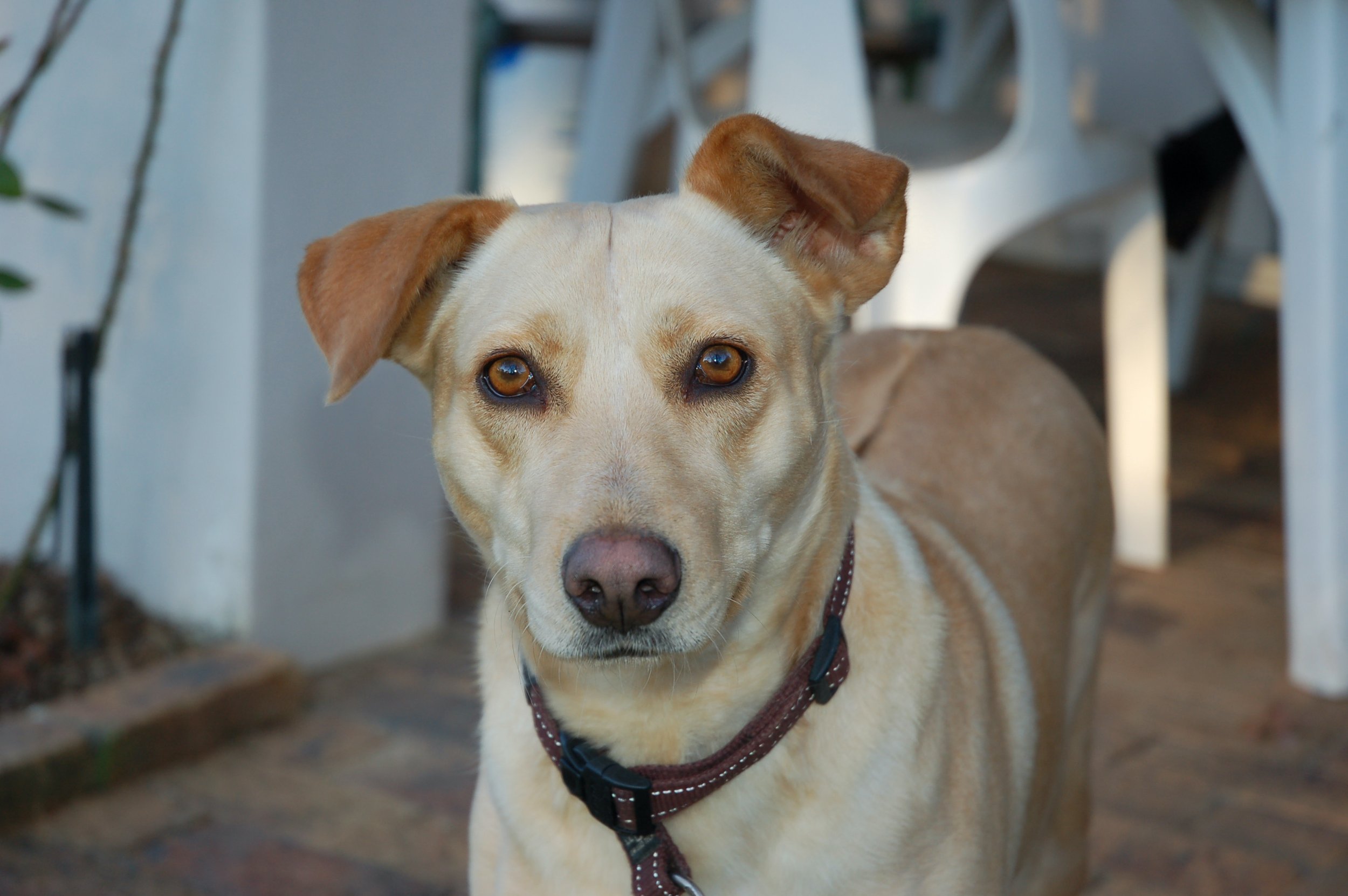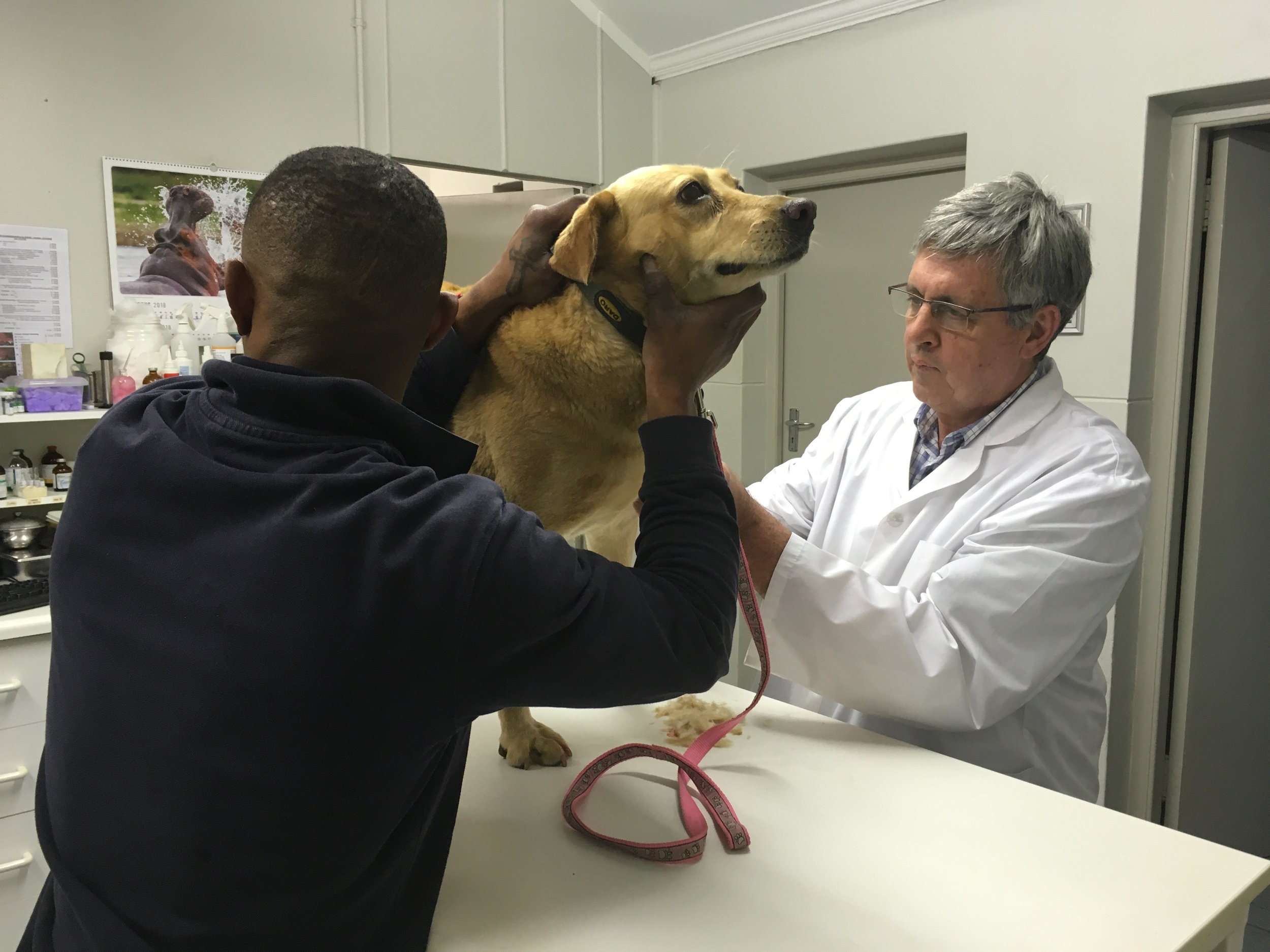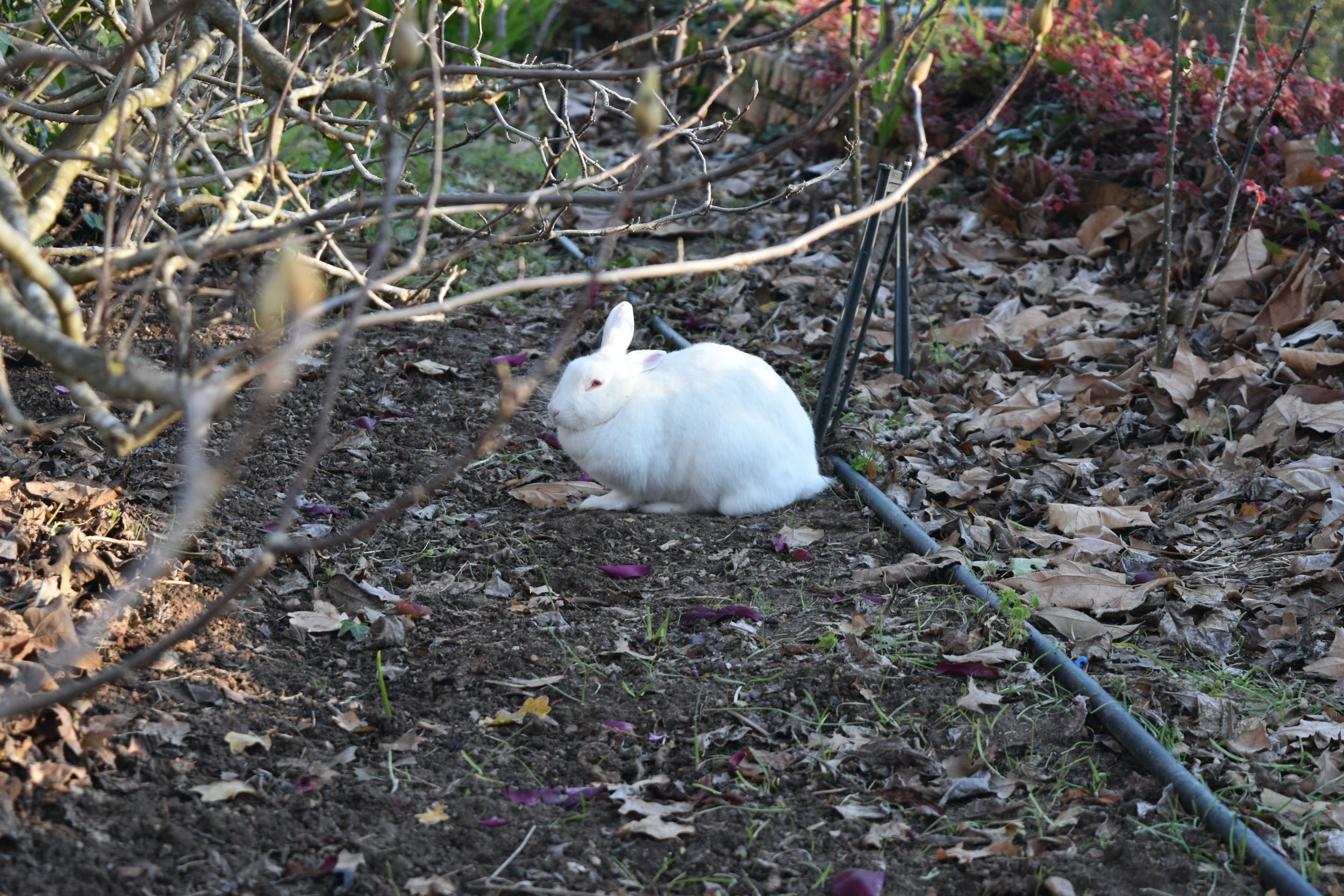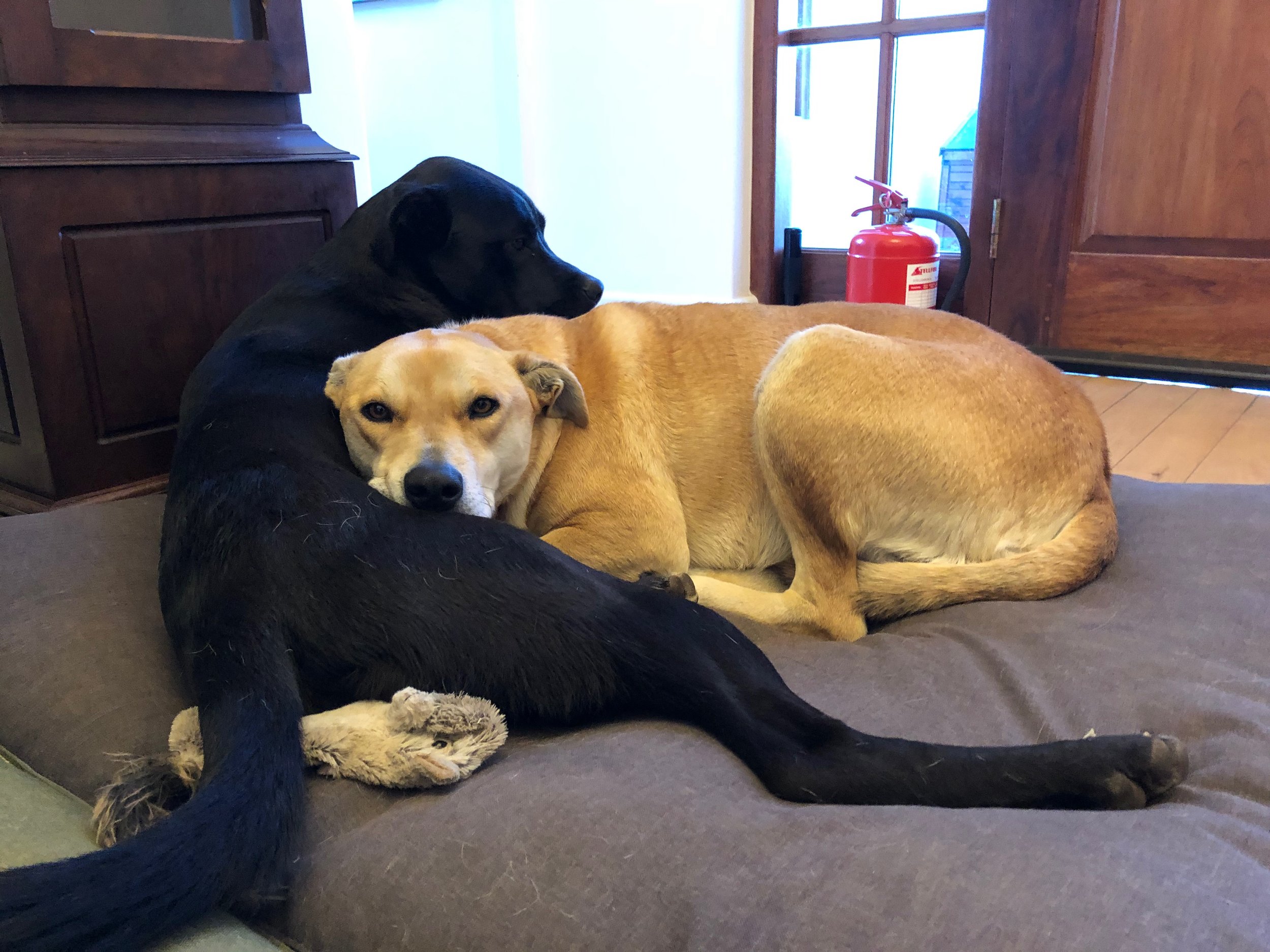When my father came to live with us he brought with him truckloads of antique furniture, much of it ball and claw, about two thousand books, many of them academic, and a medium-sized, golden-haired rescue dog called Laska. They had got on very well before Dementia undermined his lifestyle, and she was loyal and faithful, and she was part of the package.
Laska loved women and children but otherwise was on her guard
We had got used to including her in our frequent care visits, for my father’s decline impacted on her too. He developed a habit of buying different brands of dog food pellets and opening the many bags simultaneously to vary her meal. But he forgot to close them so in the kitchen I would find numerous bags of pellets open and full of ants and Laska hungry, with no food to eat. That was easy to remedy but it was an early sign that my father was not coping, and an early sign of Dementia that I missed. Laska also took to chewing sticks and sometimes they got stuck between her teeth. At one point we failed to notice the serious damage to her mouth, and only when she refused to eat did we take her to to the vet. He extracted from her gum a twig the thickness of my little finger; it left a messy, septic hole. Laska bore the investigation and extraction stoically, not flinching as the vet did his magic. My father had not noticed her injury, and we were missing the telltale signs that he could not cope on his own anymore.
Laska at the vet - I always marvelled at her stoicism and how calm and focused the vet was when we visited the Stellenbosch Animal Hospital.
Laska was the last in a long line of Laskas in our family, the first arriving before I was born. The name was taken from Leo Tolstoy’s novel, Anna Karenina. The fictional Laska was an aging setter dog and her master, Levin, one of the main characters of the novel. Laska accompanies Levin on hunts on his large rural estates. She emerges at a time in the narrative when Levin is withdrawing from city society to draw from the simpler truths of rural life. Maybe our last Laska arrived from the Animal Welfare Society at a similar time in my father’s life.
My father’s micro-estate benefitted hugely from the last Laska’s presence. She sat with him while he had his drink in the evening. She was aggressive at the gate, her hair lifting from her body in anger should an unknown person arrive. She was another presence when he was alone. She was obedient and lived in the garden and on the stoep without complaint because she was an “outside dog”. Sometimes in winter my father would allow her in to lie by the fire but that was a rare concession because he came from the old and unsentimental tradition of “werfhonde”.
The White Rabbit brought magic to the garden
Laska and my father were at their happiest in these years of his retirement. He was always around and she had a great deal of freedom and some excitement. At one point a tenant abandoned his white rabbit in the garden after he moved on. It was the kind of white rabbit a magician might pull out of a silk top hat. His ears were floppy and his body was covered with the whitest, downiest fur. He chose to live feral under the spreading branches of the African Magnolia tree which grew in a tangle close to the ground. Here he had safety and shelter and could nibble on the pink buds without disturbance. My father would sit near the tree on an old bench for his drink, and on quiet evenings the rabbit would creep out and sit near him, twitching his nose, in congenial silence. However if Laska spied the white rabbit, she would give chase and as the garden is landscaped on a slope, they would leap from terrace to terrace in an amazing race, rabbit clearing flights of steps and brick walls first, Laska extending her legs as she followed like a flying squirrel, and then the rabbit dashing back to the safety of his canopy, no doubt his heart racing fit to burst and Laska taking her place at my father’s knee. My father would look on calmly, maybe amused, sipping his goblet of white wine, while he watched the shadows lengthen, and the sun slipped behind his back and illuminated the mountain in his view in rose-pink hues.
So there was no thought that Laska should be given back to the rescue centre and while we were renovating my father’s home she came to live with us all in a red-brick rented house. We put her kennel by the front door. For the first week, she refused to sleep there but would settle at the back of the house and sleep at my father’s window. At this point, my father was very disoriented as a result of the move, and we took over Laska’s food and care. By the end of the week, rain had set in and I went out to look for Laska hoping to get her back in the kennel. Instead we found her in a little wet heap at the outside door of our bedroom - she had switched her loyalties and adopted us. From then on, my father was very much in her background. And she became an “inside dog” at night, breaking all the rules of my childhood, and delighting my own children.
The Next Generation - River and Olivia didn’t have to struggle to be inside dogs
Five years later, we are back at my father’s house, with two more dogs - both young and silly in comparison to Laska who retained her dignity and poise to the last. We had all moved back to my father’s micro-estate, and settled in. Sadly the white rabbit was preyed upon by a more ferocious beast than Laska. I found clumps of white hair on the lawn - so soft and white - and those were the only traces that he had ever existed. Maybe an eagle flying above had swooped down and got him. Maybe one of the building crew had bagged him for supper.
Laska, however, seemed to want to go on forever. We didn’t know how old she was - and by now my father’s dementia was such that he couldn’t remember when he had got her. She taught the other dogs not to run out of the gate when it opened, and she taught them how to bark at squirrels, and curse them in dog language. I found a small nest on the ground, lined with her soft tawny fur which had been coming off in clumps - the birds must have picked up the fluff and used it for insulation and warmth. She remained the principal canine authority when delivery people dropped off parcels, nervously. She was a fixture and we often joked that she and my father were timing their end together, that they were keeping each other going to a point of consensus.
Laska’s fur lining a snug nest
But Laska stopped running after the squirrels because arthritis set in and she spent more and more time on her cushion which was mostly indoors. By last year she was lying down with her legs outstretched in a dog’s version of child’s pose. The vet explained that this was to diminish the pain she was feeling in her joints. We spoke about the timing of her death, and had settled on the 15th of March, the Ides of March, that point in the year when we shifted from late summer to autumn weather and the evenings would start to be chilly, the iconic moment in the literary calendar when Brutus stabbed Julius Caesar in the back. Laska at this point was battling to walk on wooden floors and turned corners with difficulty because her legs were ramrod straight. One morning she couldn’t get up to wee and to her embarrassment wet her cushion. I knew then that that was the day, and I sat next to her and stroked her golden hair and cried big sobs of sorrow.
“I am so sorry,” I said, and looked into her brown, red-ringed eyes, which seemed to express an unfathomable depth of melancholy.
We miss her.
It was hard to say goodbye - the vet made it easier. He assessed her and believed that her brain was still fine, but her body had given up. I have marked the 25th of February in the births and deaths calendar as Laska Day.
My father doesn’t seem to notice that Laska has gone. In the end he has outlived his loyal dog and may still have many years ahead of him. Unlike her, his body still works to a degree, but his brain is giving up. That is the ongoing challenge of his Dementia.






